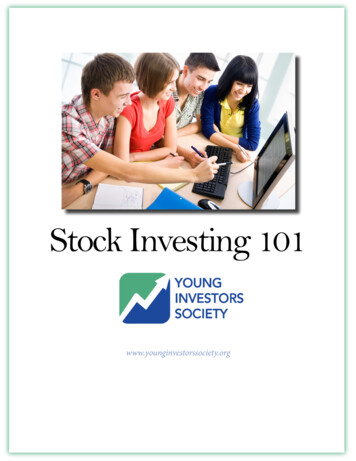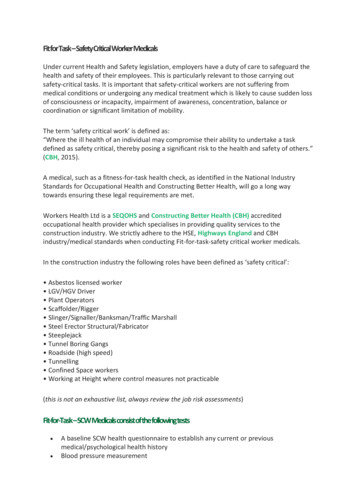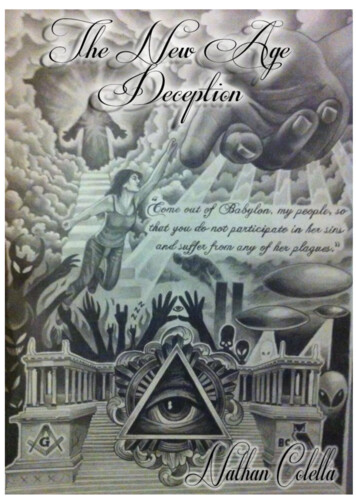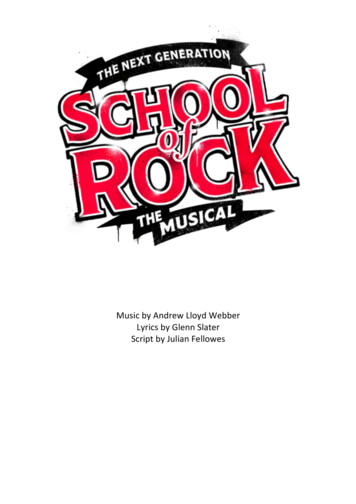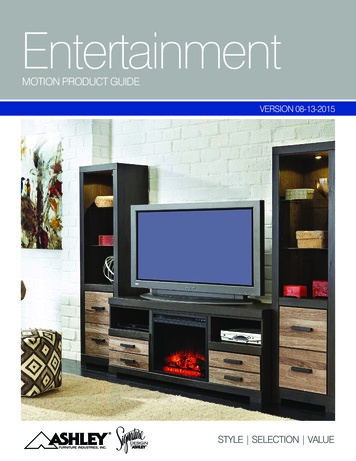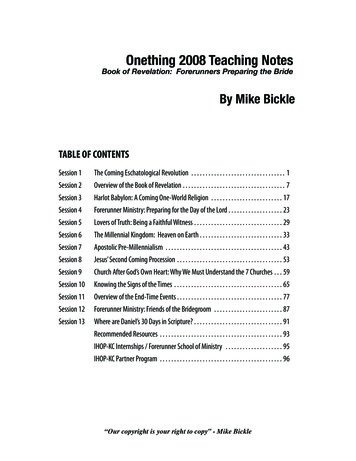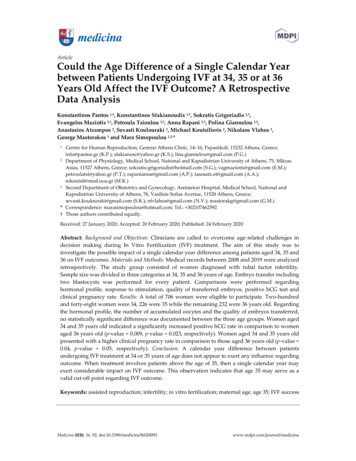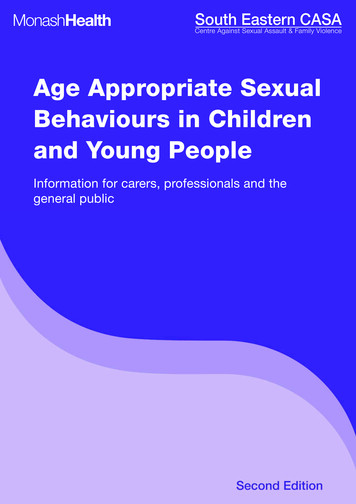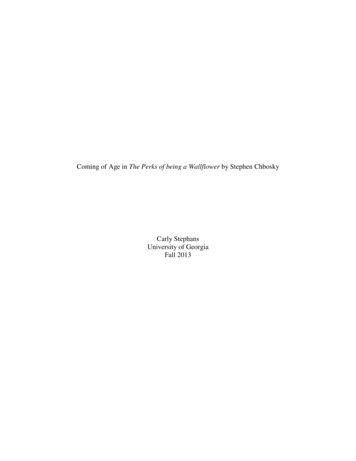
Transcription
Coming of Age in The Perks of being a Wallflower by Stephen ChboskyCarly StephansUniversity of GeorgiaFall 2013
Table of Contents:Unit Rationale page 3Parent Reading Guide page 11Goals, Assignments, and Rubrics .page 16Daily Lesson Plans pages 24-64Week One page 24Week Two .page 34Week Three .page 47Week Four .page 52Week Five page 56Week Six .Page 59
Unit RationaleWhy should this be included in the curriculum? What does it have to do with my child?"There is in every child at every stage a new miracle of vigorous unfolding."- Erik EriksonHuman development is an ongoing process that begins with our conception and continuesuntil we take our last breath. While we remain more stagnant during certain times of our lives,there are others that are filled with rapid change. One of these periods is adolescence, in whichteenagers develop psychosocially, cognitively, and morally. They must undergo these dramaticchanges that set a frame for the rest of their lives.From a psychosocial perspective, Erik Erikson outlined different stages of life as varioussituations of conflict. The conflict for adolescence is identity versus role confusion. He believedthis was the time period when humans must figure out who we are and have a solid sense of self.We navigate through different social relationships and may try out different roles. To besuccessful in this stage of development, however, we must find our personal identity (5).This quest for a firm identity along with the cognitive and moral maturation adolescentsundergo all play an integral part in how young teenagers figure out who they are going to be andwhat their beliefs are. They are maturing in their logical thinking, their identity, and their moralbeliefs. These factors are all present or developing during experiences students will have as they“come of age.” It may be their coming of age experience that really solidifies their moraldevelopment, or that helps them nail down exactly who they are.Just as adolescents are experiencing these changes, they are also present in The Perks ofBeing a Wallflower. Charlie's growth as a person is so evident from beginning to end as hematures intellectually in his English class, socially and personally through his new-found friends
and life experiences, and morally as he navigates through these sticky situations and makesmistakes. He perfectly demonstrates how growing up is messy and difficult but that it's possibleto make it to the other side. Having him as an example and reference for adolescents figuring outtheir own lives is beneficial in helping them identify their own development and harness it. Byreading all the scenarios he goes through and his thought processes behind them, teenagers canhave another source to consider what they find important and what they will focus their time andenergy on. Through the acknowledgment of the new skills and thoughts adolescents possess,they can think more rationally about what role they will play within society and what their valuesare. And reading can only help with this.These things don't really happen. My child shouldn't be exposed to these unrealistic events!“Even as kids reach adolescence, they need more than ever for us to watch over them.Adolescence is not about letting go. It's about hanging on during a very bumpy ride.”- Ron TaffelIt is very understandable to want to protect and shelter the people we love. But pretendingas if a problem doesn't exist does more harm than good. By ignoring the issues brought up in thisnovel and not discussing them with adolescents, adults are sending a message that they cannottalk about these issues. Our silence will breed more silence and that can be a perilous event giventhe prevalence of these social issues. I have collected some quick statistics to give support to thereason why we need to discuss these real-life events with teenagers. It's already going on aroundthem; it's up to us to support them or leave them to fend for themselves. 12% of females and 4.5% of males ages 12 to 17 have experienced a major depressive episodein 2012. 4
Suicide is the third leading cause of death for people between the ages of 10 and 24. 8 16% of students reported seriously considering committing suicide, 13% reported creating aplan, and 8% reported attempting suicide in 2012. 8 30% of teenagers have either been bullied or been a bully. 10 29% of sexual assault and rape victims are between the ages of 12 and 17. 11 Girls between the ages of 16 and 19 are 4 times more likely than the general population to bevictims of rape, attempted rape, or sexual assault. 11 12% of females and 5% of males in grades 9-12 reported being sexually abused. 11 93% of juvenile sexual assault victims know their attacker. 11 Victims of sexual assault are 3 times more likely to suffer from depression and 4 times morelikely to contemplate suicide. 11 9.4% of high school students report being hit, slapped, or physically hurt on purpose by theirsignificant other in 2011. 7 11% of all alcohol consumed in the U.S. is drank by people between the ages of 12 and 20. 1 39% of high school students reported drinking some amount of alcohol during the past 30days, 22% reported binge drinking, 8% reported driving after drinking alcohol, and 24% reportedriding with a driver who had been drinking alcohol in 2011. 1 9% of females and 10% of males between the ages of 12 and 17 reported using illicit drug usein the past month. 2 A little over half of high school students will have sex before graduation. 9 1 in 3 women get pregnant before age 20 and 1 in 3 of those pregnant teenagers seek anabortion. 9 5-6% of American students are lesbian, gay, bisexual, or transgendered. 6
84% of the LGBT students reported being verbally harassed due to their sexual orientation. 6 Nearly 33% of LGBT students drop out of high school to escape the violence, harassment, andisolation they face there – a dropout rate nearly three times the national average. 6These statistics are overwhelming and show the dire need we have to reach out toadolescents. It is through open dialogue and honesty that we can educate teenagers on theseverity of these problems as well as provide a support system for those already struggling withany of the above issues.Why should my child read something modern when it's the classics that have stood the testof time? Why not read Dickens or Shakespeare instead?“The books that help you most are those which make you think the most.”- Theodore ParkerCanonical literature will always hold an important place in our classrooms but it is alsoimportant to acknowledge the benefits of students reading Young Adult Literature. In our currentworld of technology and visual entertainment, any opportunity to interest teenagers in readingshould be taken advantage of. The truth is that adolescents enjoy reading about what theyunderstand. Historical literature and Shakespeare have their own educational merits, but YALgrabs young readers in ways Dickens cannot. The Young Adult Library Services Associationdescribes this literature beautifully, outlining its value in:its capacity to offer readers an opportunity to see themselves reflected in its pages.Young adulthood is, intrinsically, a period of tension. On the one hand youngadults have an all-consuming need to belong. But on the other, they are alsoinherently solipsistic, regarding themselves as being unique, which – for them —
is not cause for celebration but, rather, for despair. For to be unique is to be unlikeone’s peers, to be “other,” in fact. And to be “other” is to not belong but, instead,to be outcast. Thus, to see oneself in the pages of a young adult book is to receivethe reassurance that one is not alone after all, not other, not alien but, instead, aviable part of a larger community of beings who share a common humanity (3).Charlie's story and experiences are ones that teenagers today can relate to. They can seethemselves in him and his friends. It offers a new voice they may not have been exposed tobefore that allows them to talk about what really goes on in their lives. It's not just a boring bookabout old, dead people, but a modern tale of what it's like to be an adolescent in high school. AsYALSA describes, it is unifying for the students and allows them to bond in unexpected ways.Young Adult Literature helps the students not only in how they see themselves but howthey see each other. A bully reading about what it's like to be bullied may cause a pause forreflection. The writing is so raw and honest, it's impossible for students to not become aware ofhow they treat each other. By offering these characters different from the reader, the novel“invites its readership to embrace the humanity it shares with those who – if not for theencounter in reading – might forever remain strangers or – worse — irredeemably 'other'” (3).High school is filled with cliques and any traits that may differentiate a student are exploited.Adolescence is an emotional and exploratory time period and reading a novel such as The Perksof Being a Wallflower helps connect the students that are disconnected by social rules.Ultimately, YAL offers adolescents a new venue to explore who they are as people and asa community. It teaches them empathy for others' situations as well as comfort for their ownchallenges. There is nothing more reassuring in a time of hardship than knowing one is not alone.And there is nothing more eye opening than reading a raw account of how people are affected by
each others' actions. These mini-lessons prepare teenagers for adulthood and “the real world” asthey continue to navigate through their personal experiences, moral values, and interpersonalrelationships.What value does this book have? Where does it belong in the literary world?“A coming-of-age tale in the tradition of The Catcher in the Rye and A Separate Peace.[Chbosky's] poignant reflections on life, love and friendship are often inspirational and alwaysbeautifully written.”- USA TodayNot only does The Perks of Being a Wallflower interest students and encourage them toread, but it also provides great learning opportunities through its stylistic writing and connectionsto other noteworthy pieces of literature.The main character, Charlie, is an avid reader and mentions numerous importantscholastic novels he is reading throughout the novel. Such novels include The Great Gatsby byF. Scott Fitzgerald, To Kill a Mockingbird by Harper Lee, The Catcher in the Rye by J.D.Salinger, The Fountainhead by Ayn Rand, A Separate Peace by John Knowles, and othernoteworthy pieces of literature by authors such as Henry David Thoreau, Jack Kerouac, andShakespeare. These novels help him through his journey of maturation and he draws manyinferences from them. Providing students with a protagonist who enjoys reading, especially“academic” literature, creates a positive influence from someone they can see themselves in. It isnot a teacher or parent demanding that they read but just another teenager trying to make his waythrough life. While the novel is written by an adult, the character of Charlie is so well developedand realistic that students can appreciate Charlie as an ally rather than a ploy.
In addition to showing support for reading, it can also strengthen students' interest inwriting. The unique epistolary style Chbosky adopts is a wonderful example of multi-genrewriting that adolescents can also employ. It offers a welcomed break from the standard thirdperson narration or distant language of an analytical paper. It may open the door for students toincorporate writing into their daily lives through personal journals or letters to friends. More thanthis, it gives them a beautiful example of how their voice can be expressed and received by anaudience. Each person’s story is unique and worth telling and reading a novel such as this onemay give him or her the courage to branch out. Finally, it is important to note the nationalrecognition Chbosky has received for The Perks of Being a Wallflower. His novel was includedin the list of ALA Best books for Young Adults award and the ALA Quick Picks for Reluctantyoung Adult Readers award for the year 2000 as well as the ALA Popular Paperbacks for YoungAdults award in 2002. It is a critically acclaimed novel that promotes literacy and reading andthat ultimately, teenagers love.
References1. "Alcohol and Public Health." CDC. Centers for Disease Control and Prevention, 29 Oct. 2012. Web. 29Sept. 2013. inking.htm .2. "Availability of Illicit Drugs to Girls Ages 12-17."CRC Health. CRC Health Group, 2000. Web. 29 Sept.2013. 2-17/ .3. Cart, Michael. "The Value of Young Adult Literature." YALSA. Young Adult Library Services Association,2008. Web. 29 Sept. 2013. lit .4. "Depression rates triple between the ages of 12 and 15 among adolescent girls." SAMHSA. Substance Abuseand Mental Health Services Adminstration, 24 July 2012. Web. 29 Sept. 2013. http://www.samhsa.gov/ newsroom/advisories/1207241656.aspx .5. "Erikson's Psychosocial Stages Summary Chart." About Psychology. N.p., 2013. Web. 29 Sept. 2013. http://psychology.about.com/library/bl psychosocial summary.htm .6. "Facts: Gay and Lesbian youth in schools." Lambda Legal. Lambda Lega, n.d. Web. 29 Sept. 2013. http://data.lambdalegal.org/pdf/158.pdf .7. "Injury Prevention and Control." CDC. Centers for Disease Control and Prevention, 22 Aug. 2012. Web. 29Sept. 2013. nerviolence/ teen datingviolence.html .8. "Suicide Prevention." CDC. Centers for Disease Control and Prevention, 15 Aug. 2012. Web. 29 Sept. 2013. http://www.cdc.gov/violenceprevention/pub/youth suicide.html .9. "Teenage Abortion Statistics." Teen Pregnancy Statistics. N.p., 2009. Web. 14 Oct. 2013. nage-abortion-statistics.html .10. "Teenage Bullying." Bullying Statistics. N.p., 2009. Web. 29 Sept. 2013. bullying.html .11. "Who are the Victims?" RAINN. Rape, Abuse & Incest National Network, 2009. Web. 29 Sept. 2013. xual-assault-victims .
Dear Parents,I know this novel raises many issues that you, as a parent, may be wary of. However,these are situations that do arise in adolescents' lives and it's important for the kids to know theycan be discussed rather than hidden. I will be creating a safe and appropriate environment fordialogue that is open and honest. I highly encourage you to also have a discussion with yourchild and address these issues on your own terms. We never want anything bad to happen tochildren or young adults but in the event that something does, it's best for them to know theyhave adults who will advocate for them. To help alleviate some of your concerns and promoteyour own family discussion, I have attached the following reading and resource guide. It willprovide the breakdown of which issues occur when throughout the novel as well as helpfulwebsites for each event.I hope this helps and please do not hesitate to contact me with additional questions.Sincerely,Ms. Stephans
DepressionBook references:*Page numbers are based on Gallery Books edition of the /92174-1756/22/92197-2068/23/92208-213Guide for teenagers:http://kidshealth.org/teen/your mind/families/talk depression.htmlGuide for parents:http://www.helpguide.org/mental/depression teen.htmTreatment y/patientinstructions/000646.htmSuicideBook references:Date8/25/911/4/92Pages2-698-100Guide for sion/stop suicide.htmlGuide for parents:http://www.nasponline.org/resources/crisis ght-be-suicidal-do-i-do
Things to parents-and-teens/BullyingBook -12142-145149-155Guide for hat-to-do-if-you-are-being-bulliedGuide for parents:for those being When Your Teen Bullied/for those bullying -bully.htmWarning signs:for those being -about-Itfor those bullying our-teen-may-be-the-bullySexual abuseBook 2Pages28-3989-92167-170197-206208-213Guide for mlGuide for parents:for intrafamilial abuse:
http://nctsn.org/nctsn assets/pdfs/caring/intrafamilialabuse.pdffor general l-abuse.htmlWarning gSexualAbuse?AspxAutoDetectCookieSupport 1#teenRelationship ViolenceBook 2627-28Guide for teenagers:http://kidshealth.org/teen/your mind/relationships/abuse.htmlGuide for matepartnerviolence/teen dating x.php?q helpingWarning ognize/Alcohol UseBook 92Pages28-3942-4665-7389-92170-172Guide for re.aspx?topicID 8&articleID 25Guide for ol.html
Drug UseBook Guide for teenagers:http://kidshealth.org/teen/drug alcohol/drugs/know about drugs.htmlGuide for /2010/09/Intervention yBook uide for teenagers: de for parents: -gayPre-Marital Sex and MasturbationBook references:Date9/16/9110/6/91Pages9-1218-21
Guide for teenagers: /myths-facts-aboutmasturbation-33824.htmGuide for parents: e-Talk-Before-They-Walk-the-Walk.aspxPregnancy and AbortionBook ide for ide for px
Goals, Assignments, & RubricsMINOR ASSIGNMENTS REFLECTIVE JOURNALSGoals:1. Track personal reflections throughout novel.2. Respond to questions and engage in literary discussions concerning events and dialoguethat occur throughout the novel.3. Develop own questions and connections concerning characters and their actions/growth.Assignment:You will keep journals that track your reactions to the novel and the situations that occur. Youwill be provided prompts as well as be given opportunities for free-writes. Journals should focuson the interactions between the characters, their experiences, and Charlie's inner dialogue. Theseare your journals and may take the form you wish: you may choose to write in letter-form inresponse to Charlie or from an outsider's point of view. While the journals should be coherent,grammar and mechanics will not be graded. This assignment is to get you thinking about ideasfor discussion and the theme of Coming of Age as we progress through the novel. Journals willbe collected every Friday and should be 300 words minimum, although you may exceed thatlength.Please note, given the sensitive nature of the topics presented in the book, I am required by lawto report any hint of abuse or intention to harm oneself or another.Rubric:5 points10 pointsLengthJournals are under the 300 wordminimum requirement.Journals meet length requirementof 300 words minimum perjournal.CompletionJournals are incomplete ormissing.All journals are complete andturned in on time.CoherenceWriting is haphazard and lackcoherence.Journals are easily read andunderstood.EffortJournals indicate minimal effort Journals show signs of clearand thought given.thought and effort given.Not turning in any journals will result in zero points.Total points: /100
SCENE REWRITEGoals:1. Be able to interpret a scene from various points of view.2. Understand the depth and nuances of each character to create a realistic narrative.3. Draw connections between characters and understand the relationships between eachother.Assignment:The book is presented from the view point of Charlie, although many other characters surroundhim. Choose a pivotal scene that stands out to you, and rewrite it from the perspective of anothercharacter present. Although the actions should remain the same, you may bring up new detailsand descriptions that Charlie may have excluded. These additions can include the character'sopinion of Charlie and how he or she reacts in social situations. Your narration shoulddemonstrate an understanding of the character you are choosing as his or her own person as wellas his or her relationship with Charlie. The assignment should be a minimum of one page typed,although you may exceed this length. This paper should be a fun way to explore the events of thebooks and how people perceive each other and grow from events. Although your writing shouldbe clear and coherent, grammar and mechanics will not be a factor in your grade. Focus insteadon the ideas and narration aspect of writing.Rubric:LengthCoherenceUnderstanding0-3 pointsPaper isincomplete.4-6 pointsPaper is less thanone page lengthrequirement.The paper lacks a A voice isclear voice orestablished andswitchesmaintainedsporadically. The through some ofnarration doesthe narration.not flow andSome of theleaves the reader ideas flowconfused.coherently.Paper shows aPaper showslack ofsomeunderstanding of understanding ofthe character and the character anddescribes thedescribes theevent in a wayevent in a waythat does not fitthat sometimeswith thematches saidcharactercharacter.portrayed in thenovel.7-8 pointsPaper is less thanone page lengthrequirement.A voice isestablished andmaintainedthrough most ofthe narration.Most of the ideasflow coherently.Paper showsunderstanding ofthe character anddescribes theevent in a waythat mostlymatches saidcharacter.9-10 pointsPaper meets onepage lengthrequirement.A clear voice isestablished andmaintainedthrough thenarration. Theideas flow in anatural andcoherent manner.Paper exhibits adeepunderstanding ofthe character anddescribes theevent in a waythat matches saidcharacter.
CreativityPaper lackscreative detailsand simplyretells the eventas it happened.Leaves the readerunengaged.Paper displayssome creativedetails that showa basicunderstanding ofthe newperspective.Paper displayscreative detailsthat show anunderstanding ofthe newperspective.Paper displayscreative detailsthat show a deepunderstanding ofthe newperspective andengages thereader.Total points: /100 PERSONAL NARRATIVEGoals:1. Connect themes of Coming of Age/Personal Growth to students' own lives.2. Identify factors that lead to or inhibit growth.3. Create a personal narrative that effectively describes such growth.Assignment:Charlie and his friends go through many experiences that change them somehow. Reflect backon pivotal moments in your life and choose one in which you grew from an experience. You maywant to answer these points, although you are not limited to them: How were you before theevent? Who was involved? What happened? How did you react? How did you grow? Was yourgrowth difficult or easy? Would it have been possible to not grow from the experience? You mayexplore topics of conflict, achievement, gains or losses, etc. as long as a distinct change occursfrom the event. Changes may be physical, emotional, moral, psychological, etc. Although yournarration should be clear and coherent, grammar and mechanics will not be graded. Your papershould be a minimum of one page, though you are not limited to this length. This assignmentdoes require personal reflection as you examine your own life and coming of age journey.Please note that I am required by law to report any hint of abuse or intention to harm oneself oranother.Rubric:0-3 points4-6 points7-8 points9-10 pointsLengthPaper is incomplete. Paper is less thanone pagerequirement.Paper is less thanone pagerequirement.Paper meets onepage requirement.CoherenceA voice is neverestablished or is lostthroughout thenarration. The flowis nonsensical andA voice isestablished andpresent throughmost of thenarration. The flowA clear voice isestablished and thenarration flows in anatural andcoherent mannerA voice isestablished andpresent throughsome of thenarration. The flow
leaves the readerconfused.is natural andcoherentsometimes.is mostly naturaland coherent.through the wholepaper.Evidence of Growth Paper lacksunderstanding ofpersonal growthand the chosenevent does not showsigns of anygrowth.Paper shows someunderstanding ofpersonal growthand is sometimesevidenced throughthe chosen event.Paper showsunderstanding ofpersonal growthand is mostlyevidenced throughthe chosen event.Paper exhibitsstrongunderstanding ofpersonal growthand is evidencedthrough the chosenevent.EffortPaper sometimesshows signs ofthought and effort.The topic has somesignificance anddetails are present.Paper shows signsof thought andeffort. The topic hassignificance anddetails are present.Paper shows signsof deep thought andeffort. The topic isone of greatsignificance and thedetails are strongand engaging.Paper is writtenhaphazardly andlittle effort isshown. The topic isinsignificant andfew details areprovided.Total points: /100MAJOR ASSIGNMENTS “MIXED TAPE” COMPILATIONGoals:1. Draw connections between various forms of literacy and art.2. Effectively argue the relevance of outside art to the themes discussed in class throughanalysis of similarities and differences.3. Identify how common literary themes are present in many aspects of everyday life.Assignment:Charlie mentions many popular songs and novels through his letters and uses them as a way toconnect to others and himself during his journey. We have discussed in class how these art formsand others relate to growth and conflict as well as explored them in some of our journals. It'snow your turn to further explore this idea by finding ten forms of art that somehow express thetheme of growth or Coming of Age. These art forms may include songs, poems, photographs,etc. There are no limitations as long as you are able to explain the relationship in a paragraphaccompanying each piece of art. Each analysis should be at least 300 words, though you mayexceed this. You may examine how your chosen art forms are similar and different from ournovel as well as discuss the advantages or disadvantages for the particular medium. Thisassignment should be fun so get creative with it and pretend you are making a mixed tape for afriend.Rubric:
12345LengthFewer than tenart formsprovided andparagraphs arefewer than 300words each.Fewer than tenart formsprovided orparagraphs arefewer than 300words each.Ten art formsprovided butsomeparagraphs arefewer than 300words.Ten art formsprovided aswell as 300word paragraphfor each.Ten art formsprovided aswell as 300word paragraphfor each.MechanicsParagraphs areflooded withgrammar errorsthat distract andconfuse thereader.ParagraphsParagraphsParagraphshave frequent have mildhave mildgrammar errors grammar errors. grammar errors.that aredistracting butthe message isstill clear.Paragraphshave minimalgrammar errorsthat do nothinder reader'scomprehension.Art ChoicesChoices arerandom and donot fit withgiven theme.Choices appearrandom buthave someweakconnections tothe giventheme.Choices aremostly relevantwith mildconnections togiven theme.Choices arerelevant, fit thegiven theme,and have strongconnections.Therelationshipbetween artform and themeare minimallyexplained butlack depth een artbetween artform and theme form and themeare explainedare explainedlooselyand some depthexplained with ofminimal depth understandingofis shown.understanding.Total points: /150Accompanying TheParagraphsrelationshipbetween artform and themeare notexplained ordeveloped atall.Choices arer
Adolescence is an emotional and exploratory time period and reading a novel such as The Perks of Being a Wallflower helps connect the students that are disconnected by social rules. Ultimately, YAL offers adolescents a new ve

